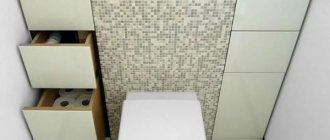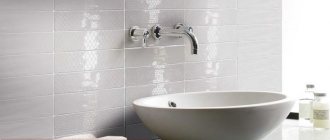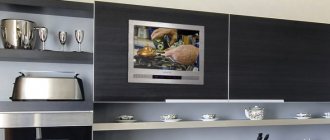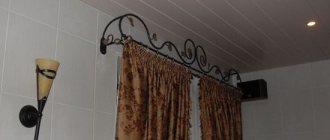Ceramic tiles are such a popular cladding option that they are used almost everywhere. Cladding of facades, staircases on the street, as well as walls and floors in domestic premises. Here are just some of the applications of ceramics.
Let's say you decide to tile the walls and floor in the toilet. Where do you start laying tiles in the toilet if you do everything yourself? What points need to be taken into account?
Preparatory work
It's rare that you can design a future toilet from scratch. Most often you have to deal with old coverings, various old wallpapers, Soviet tiles and rusty metal pipes.
Laying tiles in the toilet begins with preparatory work, which includes:
- Removal of any old cladding. If we are talking about walls, you also need to knock down old plaster that does not hold well. When dismantling the floor covering, remove everything up to the screed. At the stage of dismantling work, a hammer drill with an attachment in the form of a flat chisel will help you. Don't forget about safety: wear gloves, a respirator and goggles. Remove the old cladding from top to bottom.
- Afterwards, evaluate the floor screed and the condition of the walls. If there are irregularities, a new screed or plastering will be required.
noteSmall differences and potholes in the screed can be corrected using self-leveling mixtures. If there is a difference of a few centimeters, you will need to top up the screed or make a new floor. It all depends on the level you want to reach in the end.
- Screed, and then let the new base settle for 24 hours. After this, open the surface with a primer to remove dust and increase the adhesion of the base.
Tile texture and colors
When finishing a toilet floor, it is more advisable to choose non-slip tiles with a matte surface to protect yourself and your loved ones from falls in a damp room. Those who love gloss and shine should use a bath mat, even if the floor in the bathroom is heated.
The choice of tile colors is of great importance. For a small toilet, light pastel colors would be most appropriate: beige, blue, light green, pink, lilac, lemon. They will give the room airiness and expand it.
Larger bathrooms offer a wider range of colors when choosing materials. Black tiles would also be appropriate here. With a competent design approach, material of this color gives the room a unique chic, especially in combination with red, white or golden shades.
Lovers of noble wood motifs will love wood-effect tiles and laminate flooring. Modern technologies make it possible to produce material that is as close in texture to natural wood as possible. Outwardly, it is almost impossible to distinguish it from real wood, but during use in the bathroom with its specific aggressive environment, it will come in handy.
It is also possible to paint the tiles instead of dismantling them. This option will be appropriate if you don’t want to change the material entirely, but just need to add some variety to the decor of the bathroom. For such purposes, oil-, latex- or epoxy-based paints are used.
When painting, a wide scope for imagination opens up before the master. You can experiment with a wide variety of intricate ornaments and patterns. After the painted tiles have completely dried, they must be varnished.
The bathroom is the very place where it is especially important to feel harmonious. When choosing the color and shape of the material, it is best to focus on your own taste preferences; in this case, the result will definitely not disappoint and will delight you for a long time.
To learn how to lay floor tiles in a toilet, see the following video.
Thermal and waterproofing
Separately, I would like to highlight the issue regarding the heat and waterproofing of the floor in the toilet. Once you have removed the old covering and old screed, lay down a layer of thin foam. We are talking about durable extruded foam or other modern insulation.
What professionals say about waterproofing a bathroom - video
To avoid emergency leaks, take care of waterproofing. The rough base of the floor, even before installing the insulation, is covered with bitumen mastic. Apply two layers, maintaining a temporary pause of at least a day. Then foam plastic is installed, and the joints are again covered with mastic.
Bituminous mastic should extend onto the walls to a height of 5-10 cm. Only in this case can you be sure of the quality of waterproofing. After laying the insulation, a thick cellophane film is laid over the walls. If it is not possible to lay a single piece, an overlap is made.
Types of tiles for the toilet
Ceramics are made in different sizes: from mosaics to large panels of 60x60 cm. The color palette can be monochromatic or with patterns and ornaments. Tiles in the toilet can create a panel or an entire picture using photo printing.
The shape of ceramic tiles in the bathroom can be different, ranging from the usual standard squares and rectangles to tiles with rounded edges. As a durable floor covering, you can use natural stone (marble, porcelain stoneware). And mirrored tiles or “hog” will look good on the walls.
Installing a frame for beautiful pipe finishing
If the toilet has a riser and the pipes are not hidden, this complicates the task. You need to make a frame, and then cover it with moisture-resistant plasterboard. The frame is mounted using guides and riser profiles, and drywall is screwed to it.
Please note that it will not be possible to attach heavy tiles to drywall, so this point must be taken into account when choosing a future finish.
Patchwork in bathroom design
Using such a finish for the entire room is not only expensive, but also too rich. This material is appropriate for highlighting individual planes, for example, areas particularly susceptible to moisture and pollution. When repairing a toilet with tiles, keep in mind that on a ceramic surface with a pronounced pattern, traces of water are hardly noticeable.
Using thematic drawings and designer tiles in different styles, you can decorate your bathroom to your advantage and give the room a special lightness and mood.
No less popular is tiling with ornaments. These ceramics are often paired with plain tiles to create a bold geometric pattern or to add a colorful touch to a bathroom design. The most in demand are tiles with floral and marine patterns.
How to choose a tile?
To begin installation, you need to make sure that you have all the necessary tools and building materials. What type of toilet tiles should be used? The flooring and walls should be safe and non-slippery, which will help avoid falls and injuries.
Since this is a sanitary area, more aggressive detergents will be required for cleaning and cleaning, the surface must withstand such exposure.
All requirements can be reduced to the following:
- Resistant to chemicals and aggressive agents. The packaging must bear the designations A or AA.
- The degree of wear resistance is not lower than PEI-II, PEI-III, PEI-IV.
- The floor covering should not be slippery, so the glazed coating will come off immediately. A friction coefficient of 0.4-0.74 is an average sliding level suitable for a toilet.
- Water absorption is no more than 3%, which is due to high humidity in the room, especially if the toilet and bath are combined.
Don't forget about flower culture. If the toilet is small, light colors and a small format will help visually expand the space and make it lighter.
A combination of light and dark tiles of the same color looks beautiful. The materials must belong to the same collection; decorative inserts are possible that will help zoning the room.
When you buy tiles, make sure that the product has no defects and that the tiles do not differ in color or size.
Where are brick-like clinker tiles appropriate for interior decoration?
It is not advisable to use brick tiles everywhere. This may not be appropriate or advisable. By using such masonry on all walls inside, the room can turn into a warehouse. But separately decorated areas will look very beautiful.
Areas of the room highlighted with clinker tiles look very impressive and beautiful.
Experts identify several rooms in which tiles would be appropriate:
- In the bathroom or toilet, since these rooms are traditionally tiled. Brickwork will add charm and originality there.
- In the kitchen, because here, more than anywhere else, tiles will always be appropriate, especially for the apron. Brick-like tiles will protect the walls from various splashes, steam or soot, which are most often exposed to the cooking area.
- In the hallway or corridor, which are an area of increased risk of exposure to water or dirt. Tiles can protect your walls and give the room a noble appearance;
- You can also install it in the bedroom or living room. The most important thing is to think through all the subtleties and combination with style in advance. It is best if your room is organized in a loft style, where brickwork will be a mandatory element. The masonry can also highlight a fireplace, if you have one.
- Of course, clinker tiles will be indispensable for organizing a balcony or loggia. This option is quite popular and looks very harmonious.
That is, clinker tiles are suitable for any interior decoration. The most important thing is to approach the organization correctly and not create excessive saturation.
How to calculate how many tiles you need?
- Measure all the dimensions of the toilet, and also take into account the doorway and possible inspection doors and the like.
- By multiplying the resulting numbers, you will get the area of the room in square meters. This way you will know how many square meters of tiles you need.
- Always buy more material, with a small reserve for fighting and trimming. If you lay the tiles straight, you need 10% more, and if you lay the tiles diagonally, then 15%; in this case, more trimming will be required.
If the toilet is small, you can count the number of tiles individually. This will be a more accurate calculation option.
What tools are needed?
Learn more about what tools a professional uses in his work in this video.
To quickly and efficiently lay tiles in the bathroom, you will need the following tools:
- Tile adhesive and the tile itself.
- Plastic crosses that allow you to adjust the thickness of the seams.
- Tile cutter or grinder for trimming. To cut ceramics under a pipe or remove a strip less than 2 cm wide, you need a grinder. In other cases, when you need to cut wider strips, a tile cutter can handle it.
- Pencil or marker for making marks on ceramics.
- Building level.
- A spatula, including a serrated one, which is called a comb. A notched trowel will allow you to apply even layers of adhesive to the tile and surface.
- Rubber mallet for tapping tiles level.
- Grout for seams.
Rules for combining colors of tiles for the toilet
The catalog of companies selling tiles is simply overflowing with various collections, each of which has its own characteristics, such as design, weight, cost, color and more. To significantly simplify the process of choosing tiles for the bathroom and toilet, you should think in advance about what colors and shades you want to see in these rooms. Few people know, but the simplest color combinations can create such a chic atmosphere that even the most experienced designer will envy.
When arranging a bathroom with tiles, designers advise first familiarizing yourself with the rules of color combinations
There are several variations on how to combine shades:
- A calm transition of tones consists of choosing shades of the same color scheme. The transition can be so smooth, almost imperceptible, but after the entire composition is erected, the effect will not take long to arrive.
- Contrasting finishing is no less original and consists in the fact that with the help of a sharp difference in colors, certain accents of the room are emphasized. In other words, space zoning is carried out.
The shape of the paintings plays a big role in what colors and shades to combine in a room. In order to visually raise the walls in a room, you need to use elongated tiles, and to expand the walls, use appropriately wide ones and preferably with additional laying of the border.
Let's start laying: flooring
How to lay tiles in a toilet with your own hands if the process has been little studied? Let's figure it out. When you calculated how many tiles you needed, you already took measurements. Laying tiles begins with the same procedure.
Before you start work, watch the video - the most common mistakes when laying tiles in the bathroom and toilet
Measure the toilet and lay out all the fragments of the future lining as they should be. Draw a diagram on paper and number the tiles. And only in this case, you will see in what order to install the cladding and how much material you have available.
Let's start laying it on the wall, recommendations from professionals - video
We wrote above that there are different installation methods, but we have not yet considered how to lay tiles in a toilet in a straight line or diagonally. So what is the difference between the two styling methods.
Straight installation is recommended to create a beautiful and correct geometry. This option involves less trimming; the greatest effect is achieved in the case of smooth walls and 90-degree angles.
Features of laying on the bathroom floor - video
But sometimes the walls are uneven, so the correct geometry will not be easy to achieve. Tiling a bathroom diagonally is somewhat more complicated, but it looks beautiful and original.
Where does straight laying begin?
Here are the detailed instructions:
- We are marking the toilet; we need to find the center of the room. Find the middle of one wall and from this point draw a line at right angles to the opposite wall. Then do the procedure with the other two walls. The intersection of the lines will be the center of the toilet.
- We begin laying the cladding from the center. Glue is applied to the first tile, and the thickness of the layer is controlled with a notched trowel.
- Place the first tile along the lines, nail the tile with a mallet. You can drive away from it in all directions. Thus, the trim will be in the corners, where it will be hidden by the baseboard or corners.
- First, lay the whole tile, controlling the width of the joints with plastic crosses.
- Mark what trimming needs to be done.
note
The material is trimmed using a tile cutter or grinder. When working with an angle grinder, do not forget about safety: use safety glasses. Ceramic particles may get into your eyes.
Laying on the floor diagonally
- The starting point will be the center of the threshold of the room.
- Cut one tile in half diagonally. Perform a similar operation with a tile cutter or grinder.
- Place the resulting triangle with its end facing the threshold and its acute angle towards the room.
- The first tile will be the starting point for laying all the others.
- First, whole fragments are laid, and then the necessary trimming is carried out.
This option requires preliminary layout. Make sure diagonal mounting makes sense in your case.
Basics of material selection
Today there is a fairly large selection of bathroom and toilet tiles on sale. And you need to be able to understand this diversity. Next, we note several criteria that should help you with the choice of finishing materials:
- So, it would be wrong to select tiles based on appearance. After all, it may be intended for completely different purposes, and not for those that you require.
- When choosing a finishing material, you must take into account that floor tiles cannot be used for wall cladding. The fact is that such products are usually heavier, which is why they adhere less well to the walls.
- In addition, it is worth considering that in no case should you use thin and too fragile tiles for floor covering.
- There is no point in buying expensive tiles for public spaces. Keep this in mind when choosing.
- In addition, it is worth calculating the required number of tiles in advance, and a prepared plan with dimensions on it can help with this.
If you like a certain model of tile, then before deciding to buy, you should check it for some defects. First of all, you should determine the plane indicator, which should be minimal. In order to check this, it is enough to lean any two tiles against each other with their front sides (where the pattern is). Notice if there is space between the tiles. A gap of no more than 1.2 mm is allowed. In general, the smaller the space, the easier it will be to lay tiles in the toilet. This gap is one of the most important indicators of the quality of any ceramic tile.
In addition, it is worth checking the diagonals of the tiles, which ideally should be the same. You can safely take measurements right in the store. The difference between the diagonals should not exceed 1 mm. This indicates the high quality of the material. With such tiles the finish will be without defects.
It is also worth checking the surface of the material. High-quality tiles should be free of smudges, unevenness, cracks and other defects. In addition, it is worth checking the glaze at an angle and against the light. The interior of your bathroom may involve the use of several types of tiles. In this case, it is recommended to purchase all the necessary material from one manufacturer, even better if it is from the same series. This is important because Different manufacturers may have different production standards, which may cause problems during installation.
If you find it difficult to choose a tile, you can always turn to a sales consultant for help. Many building materials stores have special software that will allow you to simulate the design of a room using one or another finishing material. The same program, using special calculation algorithms, makes it possible to determine how many tiles you will need specifically for your room.
Tiles used as a finishing material can radically change the appearance of a room. Moreover, it can transform it both for the better and for the worse. If you choose the wrong tile design in the toilet, the room will end up looking gloomy and visually “cramped”. Perhaps it will be more clear if we give specific examples. So, a floor pattern that is too colorful will make the surface visually uneven. In addition, you should not choose dark tiles if there is already little light in the room. When using dark and light tones, there is nothing better than the classic approach of dark elements on the bottom and light elements on top. To visually make the ceiling higher, you can resort to the following simple techniques. So, for this purpose, the tiles are laid vertically, and decorative finishing elements are placed somewhere at eye level in the form of a thin border.
Installation of wall cladding
Now that we've figured out how to lay tiles on the floor in a toilet, let's move on to the walls. Professionals begin gluing tiles from the second row. The fact is that there is not always a level base from which to build.
In addition, you need to calculate that the trimming is at the bottom, and not at the ceiling, where it will attract attention. First, lay out the tiles to see how your rows will line up.
To achieve beautiful geometry, you can make the same trim on both corners, rather than a ridiculous one on one corner. For example, if the last tile needs to be trimmed by 10 cm, then start the row with a 5 cm trim and you will end up with a symmetrical 5 cm trim.
The initial row is the second from the bottom; to support it, a metal profile or rail is attached to the wall, which can then be removed. If you need to make a hole for a socket, there are special attachments - crowns of different diameters.
To finish the corners, plastic tile corners are used, which come in different colors and thicknesses.
Laying tiles in the bathroom
Floor. To work with flooring materials, as a rule, the following types of installation are used:
- Standard - in which the tiles need to be laid along the wall.
- Diagonal - the edges are laid at an angle of 45 degrees.
- The diagonal checkerboard version is distinguished by alternating ceramic tiles of different colors.
Walls. For laying wall ceramics, choose the following types of cladding:
- Direct (regular) - laying of elements is carried out parallel to the floor.
- Regular with borders - produced by alternating one wide or narrow and wide.
- Diagonal.
- Chess – played in the normal direction or diagonally.
If the bathroom is small, the tiles laid in it should be medium in size. The expansion of space will be helped by the light color of the material and diagonal laying on the floor.
It is very important to decide at the very beginning on the desired type of installation, since the diagonal option will increase the material consumption - in any case, you will have to trim the corners of the tiles to fit the corners of the walls. When selecting according to the pattern, you may also have to trim the edges of the tiles.
Grouting joints
Grouting joints on both the floor covering and the wall is carried out using a similar method. Choose high-quality grout for the toilet - options that are resistant to moisture and the appearance of fungus. The flooring does not require wide joints; minimize the distance between the tiles, which will reduce water absorption.
Rub the seams with a rubber spatula so as not to damage the surface of the cladding. Soon after application, gently wash the seams with fiberglass to give the seams a uniform appearance. Remove grout residue from the tiles immediately, otherwise it will be difficult to do.
And the final touch, when the floor is ready: how to glue the toilet? The toilet is attached to anchors, so you will need to drill holes in the tiles. If this cannot be done, use silicone caulk to seal the toilet to the tile, but this is a less reliable solution.
Bottom line: Installing tiles on the floor in a toilet with your own hands is not an easy process, but you can do it yourself. Apply all the tips from the article, and the result will exceed your expectations.
Toilet tile color
It is necessary to choose the color of the coating as correctly as possible, regardless of what tiles will be laid on the walls and floor in the toilet according to other criteria, for example: ceramic or porcelain stoneware; small or large size; in a small square or, conversely, with a large pattern. Initially, you should focus on the fact that the room is very limited, which means you need to create the effect of spaciousness, airiness and lightness. Light, delicate tones are perfect for this.
First, the choice always falls on glossy white tiles, since they contribute to the visual expansion of the room.
In turn, the white coating looks boring and sometimes even resembles medical offices. This point can be corrected very simply and all you need to do is make a creative composition from white tiles and some other color. A combination of white and sand or white and light green will look very stylish. Romantic people prefer to choose compositions made from pastel colors from Keramin, as they simply look great with white sanitary equipment and furniture of the same color.
Orange tiles will help you make your bathroom interior bright and unusual.
If you want something fresh, bright, energetic and interesting, then you should choose rich fruit colors, such as:
- Red;
- Orange;
- Green;
- Yellow.
To bring a marine theme into the rooms for hygiene procedures, you should choose shades such as blue, blue and lilac, which again can be combined with white. Such an atmosphere will have the most relaxing effect on any person and will allow you to fully enjoy water procedures. It is worth noting that not only white tiles can be installed in a room with a narrow space, but also black ones if they have a glossy finish and a golden finish. Elegant, daring and incredibly stylish - this is exactly what the toilet and bathroom will be like.











